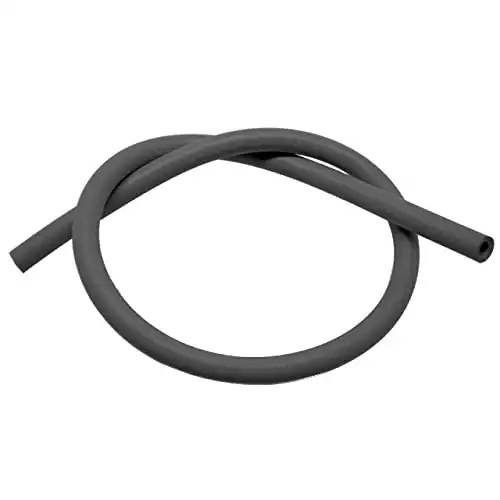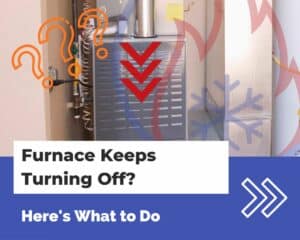Let me say this first: A furnace pressure switch that’s stuck closed is usually not a problem – it’s an indicator of a problem.
When the pressure switch closes, it signals that the inducer is producing enough airflow through the exhaust flue.
But what happens when your pressure switch remains closed, even when there is no airflow going through the flue pipe at all?
Ignoring this signal can be dangerous, especially considering the furnace deals with combustion and the potential release of harmful gases.
So, while it may be tempting to dismiss a constantly closed pressure switch or attempt a makeshift solution, it’s crucial to take it seriously.
In this article, I’ll explain what you should do if your furnace’s pressure switch is stuck closed. I’ll also go over how to tell if your pressure switch is stuck closed and provide the causes of a pressure switch that’s stuck closed.
What to Do When Your Furnace Pressure Switch Is Stuck Closed
When the furnace pressure switch remains closed, it’s essential to understand that it’s signaling a potential underlying problem.
If you suspect that your furnace pressure switch is stuck closed, here are steps you should take to address the situation:
1. Shut Off Power to the Furnace
For safety reasons, it’s crucial to turn off your furnace immediately if you believe there’s an issue. Turn off the power switch to your furnace.
2. Inspect the Pressure Switch Tubing for Cracks
Next, inspect the tubing connected to the pressure switch for any cracks or leaks.
If the tubing connected to the pressure switch cracks, then the pressure switch will get an invalid reading.
It’s worth noting that rubber tubing, commonly used to connect to pressure switches, can become susceptible to cracking over time. Be on the lookout for areas that appear rough or discolored, as these can be indicative of wear and tear.
If your furnace's pressure switch tubing has cracks or leaks, then you can use this tubing to replace it.
3. Clean Out Clogs From the Pressure Switch Tubing
When the tubing of your pressure switch gets clogged, it can cause the switch to remain closed, even if the furnace is off.
This situation arises when blockages develop in the tubing while the furnace is running, causing the pressure switch to continuously detect a pressure differential due to the obstruction – even after the furnace turns off.
If you have a high-efficiency condensing furnace, there’s a possibility of water back-feeding into the pressure switch tubing, leading to clogs.
To clear out clogs from the pressure switch tubing:
- Detach the tubing entirely from the furnace. Unhook the tubing both from the pressure switch port and the port located on the furnace cabinet near the inducer.
- Use a long, thin tool, like a wooden skewer or wire, to gently remove any debris and clear blockages from within the tubing.
- Once cleared, blow through the tubing to ensure there are no remaining obstructions.
While the tubing is removed from your furnace, it’s also a good idea to check the ports on the pressure switch and furnace cabinet. I’ll go over that next.
4. Clean Out the Pressure Switch Orifices
The orifices inside of the ports that the pressure switch hose connects to can also become clogged up with dust, soot, and other debris. They can also get clogged up by water if you have a condensing furnace.
After detaching the pressure switch tubing, utilize a tool like a small Allen wrench or a tiny screwdriver to clear the inside of the port on the switch where the hose connects.
Exercise caution while doing this; avoid pushing the tool too deep into the orifice of the pressure switch to prevent any potential damage to the switch’s diaphragm.
5. Check if the Pressure Switch Contact Is Stuck
If all else fails, you can check if the pressure switch contact itself is stuck. Regardless of everything else, if your pressure switch contact is stuck, then the switch will read as closed.
A pressure switch that gets stuck closed is almost always caused by a bad diaphragm. The diaphragm is a thin, flexible, rubber-like material that moves when it experiences a change in pressure, kind of like a balloon.
As the diaphragm ages, it tends to wear out, which can sporadically cause the pressure switch to remain closed.
If your pressure switch contact is stuck, you can try tapping on the pressure switch body with the handle of a screwdriver. This sometimes creates enough vibration to make the pressure switch open up.
However, this method provides only a brief fix. If you notice the pressure switch consistently getting stuck, you should plan to replace the pressure switch.
If you hear a flapping noise coming from your pressure switch, then the pressure switch’s diaphragm is ruptured and you need to replace the pressure switch.
A telltale sign of a bad pressure switch is a flapping sound. If a flapping noise is detected, it indicates a ruptured diaphragm, and the pressure switch should be promptly replaced.
How to Tell if Your Pressure Switch Is Stuck Closed
Most newer furnaces have distinct error codes that tell you if its pressure switch is stuck closed.
Error codes in newer furnaces have terminology like:
- Pressure switch did not open
- Pressure switch is closed with inducer off
- Pressure switch is closed before inducer is energized
- Low heat pressure switch is open while high heat pressure switch is closed (two-stage furnaces only)
If your furnace has an error code that is similar to one in the list above, then your pressure switch is stuck closed.

Older furnaces will only indicate that you have a pressure switch problem. Their error codes won’t specifically say whether the pressure switch is open or closed.
For example, the indicator light on an older furnace may indicate a problem such as:
- Pressure switch problem
- Pressure switch error
To check if your pressure switch is stuck closed when it shouldn’t be, disconnect one of the wires from the pressure switch. If your furnace inducer turns on after removing a wire from the pressure switch, then the pressure switch is stuck closed.
Once you’ve confirmed that your pressure switch is stuck closed, it’s time to move on to figuring out what’s causing the pressure switch to stay closed.
Causes of a Constantly Closed Pressure Switch
A pressure switch in a furnace is a safety mechanism designed to ensure that combustion gases are properly vented out of the home.
When the pressure switch remains perpetually closed, it could be pointing to an underlying issue in the system.
Here are some causes of a pressure switch that’s stuck closed:
Cracked Pressure Switch Tubing
Over time, the tubing attached to the pressure switch may develop cracks and deteriorate. This degradation can cause the pressure switch to receive inaccurate pressure readings.
In most cases, a cracked pressure switch hose will cause a pressure switch to read open, but in some rare cases, a cracked hose may break down and get clogged up, causing the pressure switch to stay stuck closed.
Typically, when the pressure switch hose has cracks, the switch tends to read as open. However, in some uncommon instances, a cracked hose might collapse or become obstructed, resulting in the pressure switch persistently reading as closed.
Clogged Pressure Switch Tubing
A clog in your furnace’s pressure switch tubing can cause the pressure switch to constantly read as closed.
Clogs in pressure switch tubing usually come from one of these sources:
- Soot from combustion
- Water (in high-efficiency condensing furnaces)
Follow my instructions here to clean out clogs from your pressure switch tubing.
Clogged Pressure Switch Orifice
Besides the tubing that connects to your pressure switch, the orifice on the pressure switch where the tubing attaches can also get clogged.
The stuff causing blockages in the pressure switch’s hose connection orifice are generally the same as those that might clog the hose itself: soot and water.
When clearing out the orifice of your pressure switch, it’s crucial to tread with care. Avoid inserting tools too deeply, as this could lead to potential damage to the switch.
Follow my instructions here to clean out clogs from your pressure switch’s orifices.
Bad Wiring to the Pressure Switch
If the wires connected to your pressure switch short out or make contact with each other, your furnace will interpret the pressure switch as being in the closed position.
Additionally, incorrect wiring to the pressure switch can cause it to read as closed. How does that happen?
Some pressure switches have both “normally open” and “normally closed” terminals. The difference between these terminals is their inverse readings: when the pressure switch is in a closed state, the “normally open” terminal will register a closed circuit, while the “normally closed” terminal will indicate an open circuit.
For the majority of furnace pressure switches, the correct connection is to the “normally open” terminal. If you connect the wire to the “normally closed” terminal, then your pressure switch will read as closed, even when it’s actually open.
However, to ensure proper installation, you should check the wiring schematic specific to your furnace.
Bad Pressure Switch
If everything that’s connected to the pressure switch seems to be in working order, then it could be the pressure switch itself that’s malfunctioning.
Over time, the diaphragm within old pressure switches can begin to deteriorate. The diaphragm expands and contracts when it experiences changes in pressure, triggering the pressure switch’s contact to open and close based on a predetermined pressure setpoint. But when the diaphragm starts to wear out, the pressure switch can get stuck closed.
Another way that a pressure switch can get stuck closed is when the contact itself gets stuck. This sometimes happens due to corrosion or electrical arcing, but is much less common.
In either case, you’ll need to replace the pressure switch.
I recommend replacing the pressure switch with a factory-supplied replacement with the same model number. This ensures that the pressure switch has the same form factor and pressure setpoint as the one that you’re replacing.
Is Negative Pressure in Your Home Causing Your Pressure Switch to Stay Closed?
In rare cases, an imbalance of pressure in your home might lead to your furnace’s pressure switch remaining closed.
This happens if your furnace is located inside of your home and you have a fan that’s actively exhausting air outside of your home.
Here are some examples of devices that could result in a negative pressure scenario in your home, potentially causing your furnace’s pressure switch to stay closed:
- Kitchen exhaust hood
- Bathroom exhaust fan
- Clothes dryer
- Fireplace or wood stove
If your furnace pressure switch is stuck closed while you are using any of the devices in the above list, then turn them off and see if your pressure switch opens up.
These devices only affect furnace pressure switches in rare cases, but it does happen, so I thought that I’d mention them here.
If you find that your furnace is affected by any of these devices, then consult with an HVAC professional immediately. Your furnace exhaust is potentially back-drafting into your home and creating an unsafe environment.




